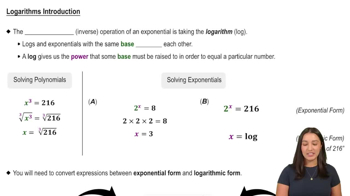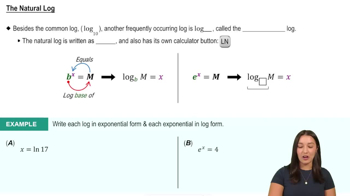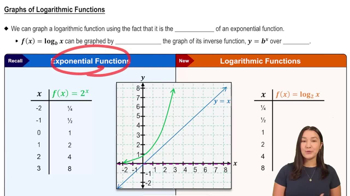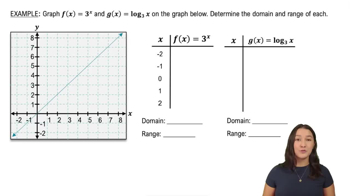Table of contents
- 0. Functions7h 52m
- Introduction to Functions16m
- Piecewise Functions10m
- Properties of Functions9m
- Common Functions1h 8m
- Transformations5m
- Combining Functions27m
- Exponent rules32m
- Exponential Functions28m
- Logarithmic Functions24m
- Properties of Logarithms34m
- Exponential & Logarithmic Equations35m
- Introduction to Trigonometric Functions38m
- Graphs of Trigonometric Functions44m
- Trigonometric Identities47m
- Inverse Trigonometric Functions48m
- 1. Limits and Continuity2h 2m
- 2. Intro to Derivatives1h 33m
- 3. Techniques of Differentiation3h 18m
- 4. Applications of Derivatives2h 38m
- 5. Graphical Applications of Derivatives6h 2m
- 6. Derivatives of Inverse, Exponential, & Logarithmic Functions2h 37m
- 7. Antiderivatives & Indefinite Integrals1h 26m
- 8. Definite Integrals4h 44m
- 9. Graphical Applications of Integrals2h 27m
- 10. Physics Applications of Integrals 2h 22m
0. Functions
Logarithmic Functions
Problem 4.2.52b
Textbook Question
{Use of Tech} Let f(x) = ln((x+1)/(x-1)) and g(x) = ln ((x+1)/(x-1)).
b. Sketch graphs of f and g to show that these functions do not differ by a constant.
 Verified step by step guidance
Verified step by step guidance1
Identify the functions: Both f(x) and g(x) are given as f(x) = ln((x+1)/(x-1)) and g(x) = ln((x+1)/(x-1)). Notice that they are identical, which suggests they should be the same function.
Understand the concept: If two functions differ by a constant, their graphs will be vertically shifted versions of each other. This means that for all x in their domain, f(x) = g(x) + C, where C is a constant.
Determine the domain: The domain of both functions is x > 1 and x < -1, since the argument of the logarithm, (x+1)/(x-1), must be positive.
Sketch the graph: Plot the graph of f(x) = ln((x+1)/(x-1)) over its domain. Since f(x) and g(x) are identical, their graphs will overlap completely, indicating they do not differ by a constant.
Conclude from the graph: Since the graphs of f(x) and g(x) are identical and overlap completely, it confirms that they do not differ by a constant. If they did, one graph would be a vertical shift of the other.
 Verified video answer for a similar problem:
Verified video answer for a similar problem:This video solution was recommended by our tutors as helpful for the problem above
Video duration:
1mPlay a video:
Was this helpful?
Key Concepts
Here are the essential concepts you must grasp in order to answer the question correctly.
Natural Logarithm
The natural logarithm, denoted as ln(x), is the logarithm to the base e, where e is approximately 2.71828. It is a fundamental function in calculus, particularly in relation to growth rates and areas under curves. Understanding the properties of the natural logarithm, such as its domain and range, is essential for analyzing functions like f(x) and g(x).
Recommended video:
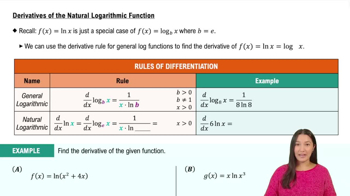
Derivative of the Natural Logarithmic Function
Graphing Functions
Graphing functions involves plotting points on a coordinate system to visualize their behavior. For functions f(x) and g(x), sketching their graphs helps to identify key features such as intercepts, asymptotes, and overall shape. This visual representation is crucial for determining whether two functions differ by a constant, as it allows for direct comparison of their outputs across the same input values.
Recommended video:

Graph of Sine and Cosine Function
Difference of Functions
The difference of two functions, f(x) and g(x), is expressed as f(x) - g(x). If this difference is a constant for all x in the domain, it indicates that the two functions are parallel and differ only by that constant. In the context of the given functions, analyzing their difference will reveal whether they maintain a consistent vertical shift or if they diverge in behavior.
Recommended video:
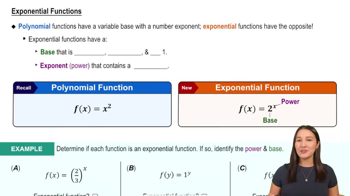
Exponential Functions

 7:3m
7:3mWatch next
Master Logarithms Introduction with a bite sized video explanation from Callie
Start learning
